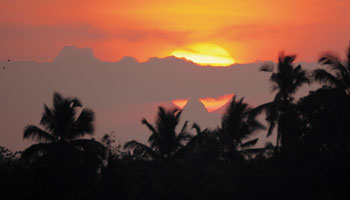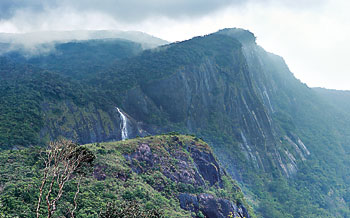Over two million people make the pilgrimage every year, trudging up the rugged steps hewn centuries ago, with faith in their hearts to venerate the sacred footprint at the summit. Ancient mariners navigated into the island's harbours guided from afar by the pyramid-shaped mount.
The Mahavamsa, the Ramayana and Mahabharata make reference to it and even today, almost everyone has their own story to share about Sri Pada, the Holy Mountain- a dawn vision of the Peak from distant Colombo or a wondrous moment, chilled to the bone at the summit yet uplifted by a golden sunrise.
 |
| Mid-March sunrise, Ratmalana |
 |
| A view from the Maskeliya trail |
Retired diplomat Sarala Fernando, currently head of the Bandaranaike International Diplomatic Training Institute and well-known photographer Luxshmanan Nadaraja, buoyed by the success of their first collaborative effort 'Gardens of Sri Lanka' thus didn't have far to look when they decided to work together on another book. Sri Pada's great appeal to travellers down the centuries sparked their interest and Sarala in her role as Editor of the publication assembled an eminent panel of contributors.
"We have all the knowledge here," she says confidently, talking of the experts who looked at the different aspects that make Sri Pada a historic, even iconic part of the Lankan landscape. That its multicultural tradition represents a spirit of tolerance and harmony, rare in the world today also was significant.
It is an erudite list of contributors. Australian Buddhist monk Ven. S. Dhammika sets the scene, his opening paragraph encapsulating the mystique of Sri Pada beautifully: "Mount Sinai was considered sacred at a much earlier date, Mount Fuji surpasses it in beauty and height, and Mount Kailash evokes a far greater sense of mystery. Nevertheless no other mountain has been revered by so many people, from such a variety of religions, for so many centuries as Sri Pada."
Luxshmanan Nadaraja is away from Sri Lanka when this preview is being compiled but Sarala mentions that he has been a regular visitor to Sri Pada. His photographs illuminate this coffee table book - stunning images, some familiar, others breathtaking - a view at dusk from the Moray Estate capturing a flaming halo around the Peak, panoramic shots, aerial photos of the mountain cloaked in lofty stillness, the jungle and its hidden denizens, and the people as they partake of an ancient time-honoured ritual.
The sense of wonder felt by travellers across the centuries, from the well documented accounts of Marco Polo and Fa-Hsien to Kashmiri monk Vajrabodhi, papal legate Giovanni de Marignolli, to Emerson Tennant and John Still is shared by almost every contributor to the book. The immense significance of the four main religions of the world- Buddhism, Hinduism, Islam and Christianity laying claim to the Peak is thoroughly dealt with. Premakumara De Silva provides a view of pre-colonial and colonial history, looking at royal patronage afforded.
Sri Pada has its place in the poetic literature of the country too he points out, being referred to in almost all message poems and poetry of the Kotte period.
The pilgrimage proper is covered in detail. In A Buddhist Pilgrim's Progress, Prof. J.B. Disanayaka outlines the physical, verbal and metaphysical purity that one should strive for and the spirit of humility in which the ascent should be undertaken describing too the landmarks along the way, while Prof. Hema Goonatilake looks at how the worship of the Buddha's footprint spread to other lands in South East Asia such as Thailand, Myanmar, Laos, Cambodia etc.
Prof. Nimal de Silva dedicates a chapter to God Sumana Saman, the guardian deity of Sri Pada while in her contribution Prof. Yoga Rasanayagam details the Hindu perspective that the mountain bears the footprint of God Siva, hence its Tamil name Sivan-oli-patha malai. Journalist and author Asif Hussein describes the Muslim connection to the place the Muslims call 'Baba Adam Malai'- ‘Mountain of Father Adam' and the belief that Adam banished from Paradise fell upon a mountain in Sarandib as Sri Lanka was then known to the Arabs.
Rev. Dr. Mervyn Fernando, founder of the Subodhi Institute takes a somewhat different tack in his 'Mountains, Water and Waterfalls- their religious and spiritual significance', asking whether it is just coincidence that the four biggest rivers of Sri Lanka have their source in the Peak Wilderness, recently declared a UNESCO World Heritage site, dealt with in this book by Siril Wijesundera, Director General of the Department of National Botanic Gardens.
Sarala echoes this important fact. And two contributors Prof. S. Kotagama and Anslem de Silva depict the montane rainforest's rich fauna- bird life, amphibians and reptiles, and the threats faced today.
Many mysteries still surround the Peak. A picture of elephant dung is in the book, but there has been no picture ever taken of elephants at the Peak, Sarala interjects, though in 1840, British engineer Major William Skinner actually reported finding elephant droppings on the very top of Sri Pada.
The chapters differ in their style and content some vastly readable, other more scholarly in their presentation. Dr. Brendon Gooneratne while writing of ancient cartographers and the legends associated with Sri Pada relates how when work on the Norton Bridge hydro-electric scheme begun in 1924 dragged on, dogged by misfortune and fears of hoodoo, Sir John Kotelawala, then a minister took a solemn vow to the guardian deity of the region, Sri Sumana (Saman Deviyo) that on the early and successful completion of the work, the Peak and the pathway leading to it would be illuminated. Work was speedily completed.
Renton de Alwis, former head of Sri Lanka Tourism recalls a family pilgrimage made as a boy of seven- the train journey on the Udarata Menike, then his slightly overweight mother toiling slowly yet joyfully up the Peak singing with devotion. "We the pilgrims, all bonded together in a momentary ritual as we passed each other. We were one family, sons and daughters of one nation. The young, old, weak and strong, we were one." In many of the writings that vein of personal connection will likely strike a strong chord with the reader.
Deloraine Brohier whose surveyor father R.L. Brohier knew its terrain well details the different trails to the Peak. Through Maskeliya or Ratnapura? The Eratne- Kuruwita route? Or an ancient path, a gradual ascent through the wilderness? Then seek help from a local guide as her father did, she advises.
The many legends associated with the Peak find their place. Ven. Dhammika touches on the wealth of gems found in the alluvial deposits at the foot of the mountain.
"The Arabs believed they were the crystallized tears Adam and Eve shed when they were expelled from paradise. The story the Chinese told about them was even more beautiful. They said that when the Buddha visited Sri Lanka, he found the people poor and given to theft. So out of compassion and to turn them to virtue, he sprinkled the island with sweet dew which crystallised into gems thus freeing the people from poverty by giving them a commodity to trade with."
 |
| Ringing the bell at the summit |
Yet it is perhaps on a spiritual quest that most Sri Lankans visit Sri Pada. As Fr. Mervyn writes: "All religions look on man's life on earth as a pilgrimage- an arduous journey from the imperfect to the perfect, from sinfulness to saintliness, from átta'to ánatta'…nothing could symbolize such a journey than climbing a mountain. Arriving at the top, the pilgrim is rewarded by a exhilarating and soul fulfilling vision of heaven. Whatever the truth of the legends of the faith-traditions of Sri Lanka …it is very understandable that they have all embraced Adam's Peak as symbolic of the spiritual quest."
"Elegant and substantive" is how Sarala visualised the book. She, Luxshmanan Nadaraja and Nelun Harasgama Nadaraja with her restrained minimalistic design can be content that they have achieved a book that is both a visual delight and an enlightening read.
"Wherever you are in the island, when you see it, it lifts your heart," says Sarala of Sri Pada. Few will dispute that.
Printed in Singapore, 'Sri Pada- Peak Heritage of Lanka' will be released in early November and is presently available at a pre-publication price of Rs. 4,900 (normal price Rs. 6, 800) until October 20. Email wildlight@sltnet.lk or call 011-2861738 for more information.
|




